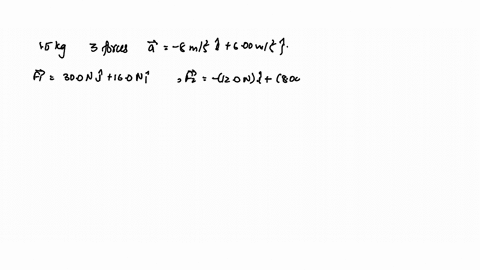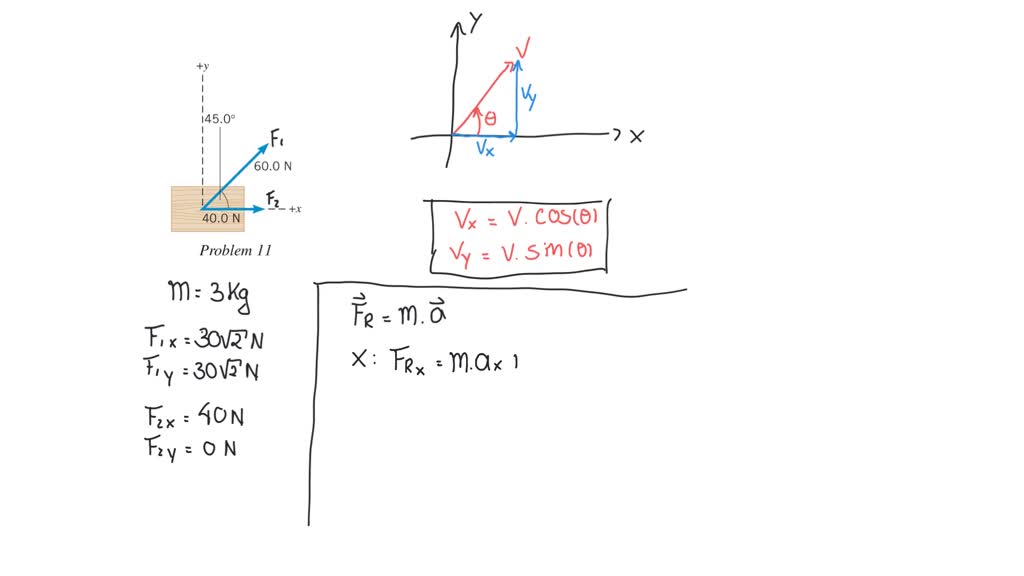Science Physics Physics questions and answers 2. A 2 kg object is subjected to three forces that give it an acceleration a = -8 î + 6ſ , in . If two of the forces are: F = 25 i + 169 in N (Newtons) and F, = -12 i +8 , also in N, find the third force. This problem has been solved!
Double Trouble: Two Body Problems
Figure 539 shows an overhead view of a 0.0250kg lemon half and two of the three horizontal forces that act on it as it is on a frictionless table.Force 1 has a magnitude of 6.00N and is at 3 0. 0 o.Force 2 has a magnitude of 7.00N and is at 3 0. 0 o.In unit-vector notation,what is the third force if the lemon half (a) is stationary, (b) has the constant velocity and (c) has the varying

Source Image: numerade.com
Download Image
Three forces act on a 2 kg object at angles theta 1 = 40 degrees, theta 2 = 60 degrees, and theta 3 = 20 degrees. Find the magnitude of F2 and F3 if the magnitude of F1 is 1 N and the acceleration of the object is 1.5 m/s^2 toward the + x direction. y F₁ F3 0₂ F₂ 03 Company Freedman, College Physics, 3e, 2021 W. H. Freeman and

Source Image: chegg.com
Download Image
⏩SOLVED:Only two forces act on an object (mass 3.00 kg), as in the… | Numerade A 2.80 kg object is subjected to three forces that give it an acceleration a = (4.10 m/s^2)i + (5.50 m/s^2)j. If two of the three forces are F1 = (24.0 N)i + (14.0 N)j and F2 = (11.0 N)i + (6.10 N)j, find the third force. Transcript. Hey everyone welcome back in this question. We are given with the mask and the value of masses to Katie.

Source Image: homework.study.com
Download Image
A 2kg Object Is Subjected To Three Forces
A 2.80 kg object is subjected to three forces that give it an acceleration a = (4.10 m/s^2)i + (5.50 m/s^2)j. If two of the three forces are F1 = (24.0 N)i + (14.0 N)j and F2 = (11.0 N)i + (6.10 N)j, find the third force. Transcript. Hey everyone welcome back in this question. We are given with the mask and the value of masses to Katie. Concept explainers Question Transcribed Image Text: A 2.00 kg object is subjected to three forces that give it an accelerationd = – (8.00m/2)i+ (6.00 m/,2)}. If two of the three forces are F = (30.0N)i + (16.ON)j and F, = – (12.0N)E + (8.00N)f, find the third force in Newtons.
Two objects with masses of 3.00 kg and 5.00 kg are connected by a light string that passes over a frictionless pulley. Find (a) the tension in the string, (b) the acceleration
A 2.0 kg object is subjected to three forces that give it an acceleration of a = (-8.0m/s^2)I + (6.0m/s^2) j. If two of the three forces are F_1 = (30.0N)I + (16.0 N)j and F_2 = (-12.0 N)I + (8.0 N)j, find the third force. This problem has been solved! Finding the resultant force given three forces – YouTube

Source Image: m.youtube.com
Download Image
Newtowns 2nd law: The acceleration of an object as produced by a net force is directly proportional to the… | Engineering notes, Physics classroom, Physics concepts A 2.0 kg object is subjected to three forces that give it an acceleration of a = (-8.0m/s^2)I + (6.0m/s^2) j. If two of the three forces are F_1 = (30.0N)I + (16.0 N)j and F_2 = (-12.0 N)I + (8.0 N)j, find the third force. This problem has been solved!

Source Image: pinterest.com
Download Image
Double Trouble: Two Body Problems Science Physics Physics questions and answers 2. A 2 kg object is subjected to three forces that give it an acceleration a = -8 î + 6ſ , in . If two of the forces are: F = 25 i + 169 in N (Newtons) and F, = -12 i +8 , also in N, find the third force. This problem has been solved!

Source Image: physicsclassroom.com
Download Image
⏩SOLVED:Only two forces act on an object (mass 3.00 kg), as in the… | Numerade Three forces act on a 2 kg object at angles theta 1 = 40 degrees, theta 2 = 60 degrees, and theta 3 = 20 degrees. Find the magnitude of F2 and F3 if the magnitude of F1 is 1 N and the acceleration of the object is 1.5 m/s^2 toward the + x direction. y F₁ F3 0₂ F₂ 03 Company Freedman, College Physics, 3e, 2021 W. H. Freeman and

Source Image: numerade.com
Download Image
A 2 kg object experiences two concurrent forces of 100 N at 30 degrees above the positive x-axis and 80 N at 60 degree above the negative x- axis. What is the The vertical forces balance each other since there is no vertical acceleration. The only unbalanced force on the 10.0-kg object is the Fcontact. This force is the net force and is equal to m•a where m is equal to 10.0 kg (since this analysis is for the 10.0-kg object) and a was already determined to be 3.0 m/s 2. The net force is equal to 30.0 N.
Source Image: quora.com
Download Image
There are two forces on the 2.00,kg box in the overhead view of Fig., but only one is shown. For F_1 =20.0,N,a= 12.0,m/s^2, and theta= 30.0^o, the second force (a) in unit-vector A 2.80 kg object is subjected to three forces that give it an acceleration a = (4.10 m/s^2)i + (5.50 m/s^2)j. If two of the three forces are F1 = (24.0 N)i + (14.0 N)j and F2 = (11.0 N)i + (6.10 N)j, find the third force. Transcript. Hey everyone welcome back in this question. We are given with the mask and the value of masses to Katie.

Source Image: toppr.com
Download Image
Physics HL: How do I solve this question? : r/IBO Concept explainers Question Transcribed Image Text: A 2.00 kg object is subjected to three forces that give it an accelerationd = – (8.00m/2)i+ (6.00 m/,2)}. If two of the three forces are F = (30.0N)i + (16.ON)j and F, = – (12.0N)E + (8.00N)f, find the third force in Newtons.

Source Image: reddit.com
Download Image
Newtowns 2nd law: The acceleration of an object as produced by a net force is directly proportional to the… | Engineering notes, Physics classroom, Physics concepts
Physics HL: How do I solve this question? : r/IBO Figure 539 shows an overhead view of a 0.0250kg lemon half and two of the three horizontal forces that act on it as it is on a frictionless table.Force 1 has a magnitude of 6.00N and is at 3 0. 0 o.Force 2 has a magnitude of 7.00N and is at 3 0. 0 o.In unit-vector notation,what is the third force if the lemon half (a) is stationary, (b) has the constant velocity and (c) has the varying
⏩SOLVED:Only two forces act on an object (mass 3.00 kg), as in the… | Numerade There are two forces on the 2.00,kg box in the overhead view of Fig., but only one is shown. For F_1 =20.0,N,a= 12.0,m/s^2, and theta= 30.0^o, the second force (a) in unit-vector The vertical forces balance each other since there is no vertical acceleration. The only unbalanced force on the 10.0-kg object is the Fcontact. This force is the net force and is equal to m•a where m is equal to 10.0 kg (since this analysis is for the 10.0-kg object) and a was already determined to be 3.0 m/s 2. The net force is equal to 30.0 N.